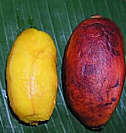Fe'i banana
(Redirected from Fei banana)
Fe'i banana refers to a group of banana cultivars found primarily in the Pacific Islands, particularly in Polynesia, Micronesia, and Melanesia. These bananas are distinct from the more commonly known Cavendish banana and are notable for their unique characteristics and cultural significance.
Description[edit | edit source]
Fe'i bananas are characterized by their upright fruiting habit, where the bunches grow vertically rather than hanging down. The fruits are typically orange to red when ripe, and the flesh is often a deep yellow or orange. This coloration is due to the high levels of beta-carotene, a precursor of vitamin A, making them a valuable nutritional resource.
Cultivation[edit | edit source]
Fe'i bananas are traditionally grown in the rich volcanic soils of the Pacific Islands. They are well-adapted to the tropical climate and are often cultivated in mixed gardens alongside other staple crops such as taro, yam, and breadfruit. The plants are hardy and can thrive in a variety of soil types, although they prefer well-drained soils.
Cultural Significance[edit | edit source]
In many Pacific Island cultures, Fe'i bananas hold significant cultural and ceremonial value. They are often used in traditional feasts and rituals. The bright orange and red colors of the fruits are also symbolically important in various cultural contexts.
Nutritional Value[edit | edit source]
Fe'i bananas are rich in beta-carotene, which is converted into vitamin A in the human body. This makes them an important food source for preventing vitamin A deficiency, which can lead to serious health issues such as night blindness and an increased risk of infections.
Varieties[edit | edit source]
There are several varieties of Fe'i bananas, each with its own unique characteristics. Some of the well-known varieties include:
- Fe'i Aiuri
- Fe'i Asupina
- Fe'i Utafan
Uses[edit | edit source]
Fe'i bananas are consumed in various ways. They can be eaten raw when fully ripe, but they are often cooked, baked, or boiled. The leaves of the Fe'i banana plant are also used in traditional cooking methods, such as wrapping food for baking or steaming.
Conservation[edit | edit source]
The cultivation of Fe'i bananas has declined in some areas due to the introduction of more commercially viable banana varieties. Efforts are being made to conserve these unique cultivars through agricultural programs and by promoting their nutritional benefits.
See Also[edit | edit source]
References[edit | edit source]
External Links[edit | edit source]
Search WikiMD
Ad.Tired of being Overweight? Try W8MD's physician weight loss program.
Semaglutide (Ozempic / Wegovy and Tirzepatide (Mounjaro / Zepbound) available.
Advertise on WikiMD
|
WikiMD's Wellness Encyclopedia |
| Let Food Be Thy Medicine Medicine Thy Food - Hippocrates |
Translate this page: - East Asian
中文,
日本,
한국어,
South Asian
हिन्दी,
தமிழ்,
తెలుగు,
Urdu,
ಕನ್ನಡ,
Southeast Asian
Indonesian,
Vietnamese,
Thai,
မြန်မာဘာသာ,
বাংলা
European
español,
Deutsch,
français,
Greek,
português do Brasil,
polski,
română,
русский,
Nederlands,
norsk,
svenska,
suomi,
Italian
Middle Eastern & African
عربى,
Turkish,
Persian,
Hebrew,
Afrikaans,
isiZulu,
Kiswahili,
Other
Bulgarian,
Hungarian,
Czech,
Swedish,
മലയാളം,
मराठी,
ਪੰਜਾਬੀ,
ગુજરાતી,
Portuguese,
Ukrainian
Medical Disclaimer: WikiMD is not a substitute for professional medical advice. The information on WikiMD is provided as an information resource only, may be incorrect, outdated or misleading, and is not to be used or relied on for any diagnostic or treatment purposes. Please consult your health care provider before making any healthcare decisions or for guidance about a specific medical condition. WikiMD expressly disclaims responsibility, and shall have no liability, for any damages, loss, injury, or liability whatsoever suffered as a result of your reliance on the information contained in this site. By visiting this site you agree to the foregoing terms and conditions, which may from time to time be changed or supplemented by WikiMD. If you do not agree to the foregoing terms and conditions, you should not enter or use this site. See full disclaimer.
Credits:Most images are courtesy of Wikimedia commons, and templates, categories Wikipedia, licensed under CC BY SA or similar.
Contributors: Prab R. Tumpati, MD






